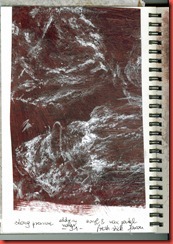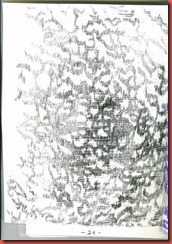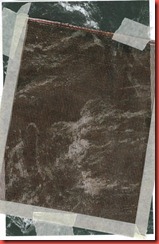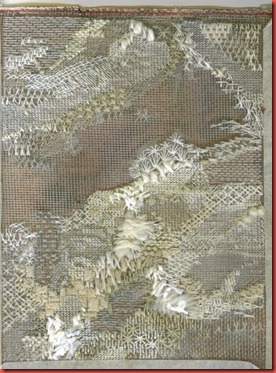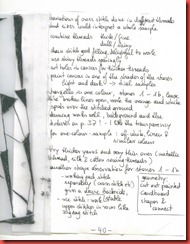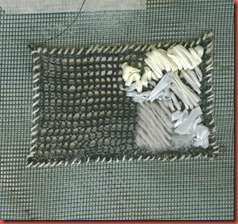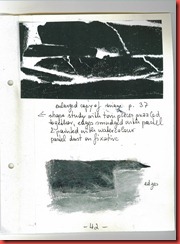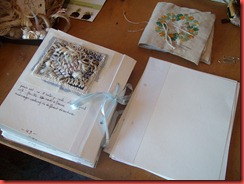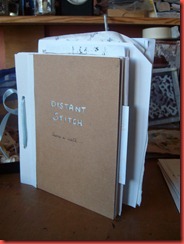and a little more besides …
Chapter 5: Teach yourself some canvas stitches, covering small areas to see what they will look like in repeat.
I had bought Margaret Rivers' book „Working on Canvas“ and took the book, a piece of canvas size A5 (16 holes per inch) and a couple of threads in several colours with me on holiday. Keeping my old father company in front of the TV gave me enough time to try out a couple of stitches. The colours were chosen with the photograph of my wall and my colour studies in view. With the dark negative forms of my wall in mind I thought a dark background best for the sample and had painted the canvas with acrylics. I found that handling the piece during stitching rubbed off the paint a little, resulting in a mottled effect which relates to the stone surface.
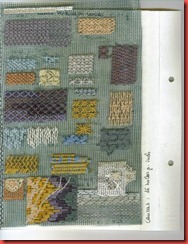 | 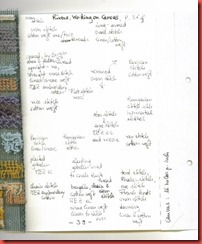 |
I found the many variations of cross stitch most interesting, worked with soft threads that cover the ground evenly or with threads like linen that have a mind of their own.
Different degrees of transparency emerged when I worked with one or two thin threads. I like the combination of darning, tent stitch and more raised stitches on the lower right on page 39 a lot. The dull cotton and linen threads are more suited to the stones than the shiny cotton threads.
Back at home I read the instructions in the Taster Module again and found that I should have chosen one colour. As I had really enjoyed the stitching I prepared another piece of canvas and tried a variety of cross stitches and some others with off-white and greyish threads, bleached and unbleached linen and cotton weft threads, handspun silk, a 4-ply viscose knitting yarn, a fluffy viscose knitting yarn, cotton perle, chenille and handspun wool .
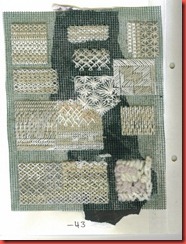 | | 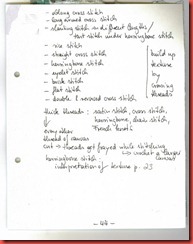 |
My chief aim was to cover areas rather than look at individual stitches, and I found it interesting to layer stitches, like herringbone stitch on tent stitch. The dark background shows even through densely stitched areas and emphasizes the relief. The threads I had chosen worked well except for the 4-ply knitting yarn which wanted to unravel in all directions during stitching. The linen threads have a stiffness that relates well to the stones, they give a little irregularity to the stitched surface. The shiny threads like cotton perle make for a softer surface and catch the light nicely.
My canvas is rather fine, so I cut every other thread in the square below to the right for working with bulkier threads. A stubble of cut canvas remains in the holes and tends to fray the threads. It works however for a small area with short lengths of threads.
Chapter 6: A sample in one stitch, worked in small areas in many different threads in one colour
I decided to stay with my chosen colour range of natural off-white threads and choose oblong cross stitch for this sample. I also used the same canvas with 16 holes per inch, painted greenish-grey with acrylics.
I had looked around for canvas of a larger gauge, but shops of this kind have become very scarce. Ordering from the internet is of course possible but I decided against it as I only needed small pieces – and I also liked the stitching on the fine canvas and wanted to combine a smaller and larger gauge in one piece.
I crocheted a small piece of „canvas“ and, for a second alternative, took a piece of potato net. I painted both pieces with acrylics, which also stiffened the fabric a little and made stitching easier. Both pieces were easy to work with and easy on the threads.
This is the crocheted piece, made with a size 12 crocheting hook and MEZ 40 thread. It is about 3,5 x 2,1 inches in size and has 8 holes per inch. I used several woollen threads, chenille, raffia, a short strip of cut organdy which came apart after a few stitches and cut strips of a plastic bag which I like very much. They give quite a different character to the stitches. The raffia is also lovely, especially the French knots in the lower left corner, stiff and full of edges. I used Rhodes stitch to build up the bulky threads to a really high relief, also satin stitch and fly stitch.
 | The potato net is 4 x 3,5 inches in size and also has about 8 holes per inch, but the grid is slanted, which makes for interesting shifts in direction. It needs a firm frame, so I inserted it in canvas with tent stitch, cross stitch and herringbone stitch. |
I used mostly the same threads as in the crocheted net, but added handspun linen and especially a fine variety of cord for wrapping parcels. I tried some Rhodes stitches with that, and it is so stiff that it builds a structure of its own on the soft ground. Another direction for further experiment!
________________________
In between I did a few things on the side to give myself a rest from stitching.
The shapes of the stones still intrigued me and I wanted to stay with them a little longer.
-
I tore pieces from an old calendar and arranged them on dark paper. Afterwards I overlaid them with two layers of light grey organdy to mute the strong colours a little. The organdy makes for a wavelike sheen over the whole piece. I laid an enlarged copy of page 26 of my sketchbook over the piece and stitched the lines on the machine with zigzag stitch. Finally I tore the paper away between the stitched lines. Two different recordings of the wall are combined here, but in my opinion it is not successfull. When I look at the piece I keep switching between the lower and the upper layer.
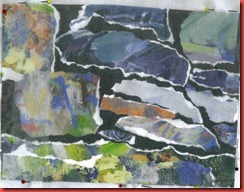 | 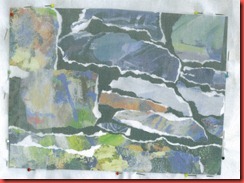 |
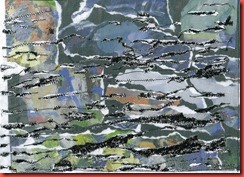 | I chose the colours to echo the colours of the stones and paid attention to the edges. The torn edges from the machine stitchery add to these white traces.
size: about A4 |
Later I played with the scanned image on the computer and got some interesting results.
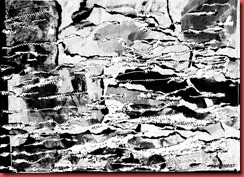 | 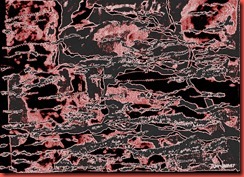 |
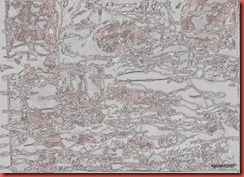 | 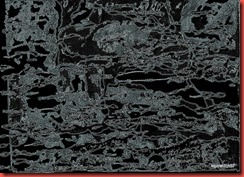 |
| The third image reminds me of an illustration for a fantasy novel but I do not remember which. | |
-
I wanted to explore the edges of the stones a bit more. I tore an acrylic-painted sheet of paper to bits, taking care to leave broad edges of torn white paper. The bits were glued like jigsaw pieces to form the shapes of the stones in a chosen area of the photograph. I followed the structure of the stones whenever possible. I worked over the glued page with watercolour to soak the torn edges within the stones and applied several layers of white and coloured pastels to emphasize the texture.
-
With the reverse image of one of my tracings before me ( sketchbook page 26 in my former post) I applied bleach to an old piece of cotton fabric in broader or finer strokes, trying to recapture the striped effect. I tore the fabric to stripes, rearranged them and ironed them on bondaweb. I like the frayed edges with their thin threads spreading out. I have put it away for now and intend to come back to it later on.
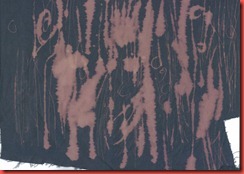 | I used the nozzle of the pipette to apply the bleach. The effect took a few minutes to show, then the lines and blotches spread out. For the fine lines I tried a glass nib and found it worked very well. It moves smoothly over the fabric and leaves fine scratches. |
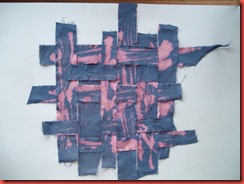 | 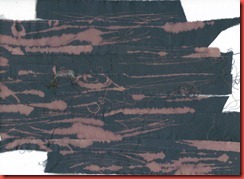 |
A small piece was stitched with contrasting threads to give crispness to the smooth fabric. I also tried textile pastels on it and added it to my colour studies (page 32 b).
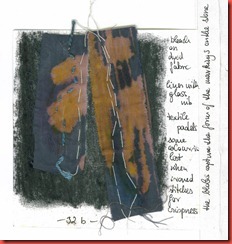
Finally I reassembled my sketchbook. The book was spiral-bound and had become so bulky with all the material that I could hardly turn the pages any more, although I had already taken out a couple of sheets for more space – and the stitch samples were still to be added. So I removed the spiral and glued two strong strips of paper to each page, made holes and now keep the pages together with a ribbon. This way the book can take in as much as I want to, I can add pages anywhere I like, and it opens easily. That is how it looks like now.
And here my little helper. I am always working under supervision  .
.
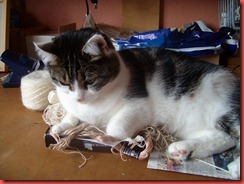
____________________________________________________________
Chapter 6 continued:
I chose oblong cross stitch to try out, using cotton and linen weft threads, machine sewing silk, metal embroidery thread, cotton perle, knit tube, handspun silk and linen, raffia, wrapping thread, plastic strips, Danish flower thread, knitting cotton/linen yarn.
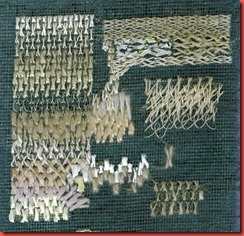 | I worked in regular rows horizontally and vertically. The vertical rows are more brick-like. The stitch also lends itself well to lines and irregular areas. I like the lacy texture of the metal thread.
I liked the backside of the regular stitching on the left so much (see photograph below) that I worked the stitch backside up (middle right). |
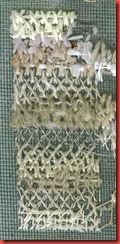 | It took me some time to figure out the logic of that. |
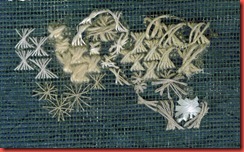 | I also tried half Rhodes stitch. Here again the stiff parcel cord gives a very interesting result. |
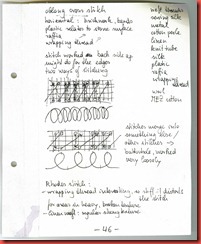
Trying to figure out the ways of working oblong cross stitch backside in front on paper. I found two ways to do it with very different results.











